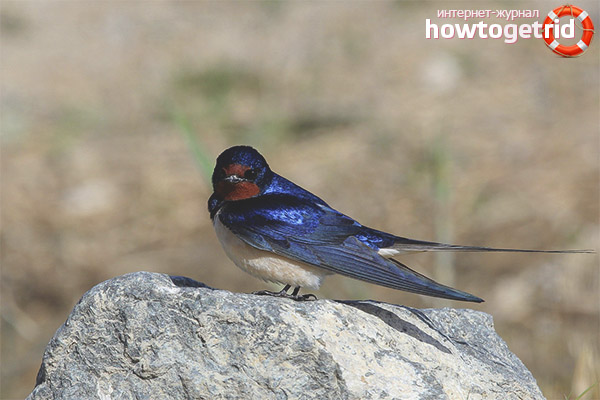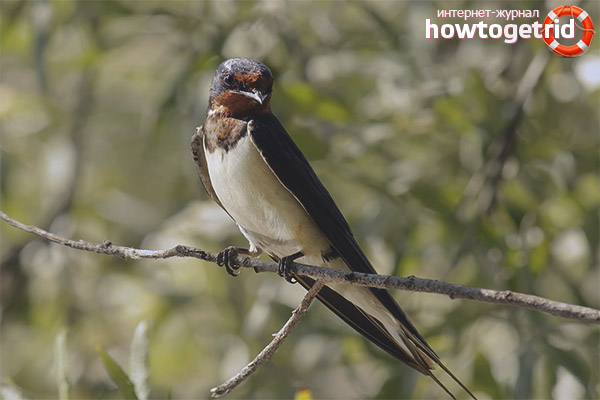The content of the article
With the onset of spring, when nature comes to life, swallows return to their nests. The population of these small migratory birds is considered the largest in our latitudes. Barn swallow likes to settle in the immediate vicinity of human habitation. Therefore, since ancient times, many folk beliefs have been associated with this bird.
In addition, the swallow of the Slavic peoples is one of the main symbol of spring. This bird also personifies the world, prosperity, family well-being. There is such a belief: if a swallow arranged a nest for itself under the roof of human housing, then the family will not know poverty. In these beliefs there are many understandable meanings, because this nimble bird is busy all day long with the extermination of harmful insects. In such a simple way, village swallows bring tangible benefits to a person.
View description
Village swallows are distinguished by a very attractive appearance: the plumage of the bird is painted in blue-black tones from above, and the abdomen in a contrasting pale beige hue. On the graceful neck of the messenger of spring there are bright spots with a brown tint. It should be noted that the plumage of the male is colored brighter than that of the female. On this basis, it is not difficult to distinguish a “girl” from a “boy”. Sex can also be determined by the length of the tail - in the female it is slightly shorter.
The adult individual swallow reaches the following parameters:
- weight - up to 20 g;
- body length - about 20 cm;
- wingspan - 30-35 cm.
Where the swallows live
The habitat of the Barn Swallow is quite extensive. The bird is distributed on almost all continents. Its nests are found in the north of Africa and America, the bird lives in the European regions and Asia. When summer ends, swallows in search of warmth go south to return to their native lands again in spring. Barn swallows prefer to equip their nests in rural areas. However, it is not difficult to understand by the name of the species of birds.
Birds make nests usually on the upper part of the walls of apartment buildings, sheds. They feel comfortable at the small stables. Barn swallows do not like noisy, crowded places; they prefer quiet privacy. Some caring owners, wanting to attract these useful birds, construct structures specially for them that are convenient for nesting. Such caring for birds helps to maintain a population of these beneficial birds.
Way of life

For the barn swallow daytime is familiar. In mid-May, having returned after a long wintering, she was taken to equipping her own home. At the end of construction work, in the first days of June, birds begin to lay their eggs, then offspring are waiting. Although this species of swallows nests in colonies, this does not prevent each individual pair of birds from jealously guarding the borders near their own homes.
The Barn Swallow is a social bird. Usually this species forms large flocks in the places of settlement. Birds like to gather in groups to rest. At the same time, they often arrange peculiar concerts, sitting down in a chain on wires, and then announce the surroundings with loud twitter. In the final part of the speech, a trill is pleasant to the human ear.Barn swallows often fall to the ground, which distinguishes them from other varieties of this bird. In September, when the approach of cold weather is clearly felt, the swallows again gather in large flocks and go for wintering closer to the equator.
Eating swallows
The diet of this small bird is made up of small insects: mosquitoes, midges, butterflies, dragonflies, flies. In rainy weather, when insects hide, the swallow changes its gastronomic predilections and preys on caterpillars and spiders. It is these changes that explain the characteristic feature of swallows flying low above the surface of the water before rain. Insects, sensing the approach of bad weather, clouds rush near the water. And the swallows use this situation to their advantage, easily getting their own food.
I must say that the chicks of the barn swallow are voracious. For this reason, parents are forced to spend whole days in search of food for their insatiable cubs. They bring food for babies in the esophagus. To feed five chicks, adult birds must deliver about four hundred servings of food to the nest.
Propagation Features
Swallows are recognized as masters of construction. Their nests are neat and regular in shape. For construction, they use clay, lumps of earth, the remains of straw. The swallow's nest looks like an open bowl, the inside of which is necessarily lined with feathers and soft grass. Usually a female lays no more than five eggs.
In the process of hatching, the male actively helps his girlfriend. He replaces her in an important post when the expectant mother needs to eat. After 14-18 days, cubs appear. Parents take care of the babies for three weeks, feed them intensely. Then young swallows begin an independent life and leave their parental nest. Interestingly, a pair of swallows is not limited to one brood; under favorable climatic conditions, they manage to release their offspring three times in one season.
Interesting Facts
- If the chicks from the last brood did not get stronger before the onset of cold weather, the parents do not leave their cubs to their own devices. They stay with the kids, waiting until they are able to make a long flight.
- Swallows that spend the winter in Africa switch to ants. They really like that kind of variety.
- Not all swallows withstand a long journey. During the migration period, many birds die of hunger and fatigue.
- The life of a village swallow is always accompanied by a song: she sings in search of food, sings in the short minutes of rest.
- And one more interesting historical fact. In ancient Rome, after chariot races, the swallows tied the colors of the winner to the paws, and then released it into the sky. This tradition identified the hero’s victory with free flight.
Video: Barn Swallow (Hirundo rustica)











Submit